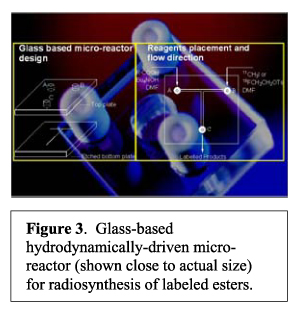2 Research Method Development
2.6 Miniaturization of radiochemistry
 Typically, radiochemistry with fluorine-18 or carbon-11 is conducted on a scale that uses 0.1-5 mg of precursor and 0.2-2 Ci of radioactivity in reaction volumes of 0.5-1 mL. Commercial state-of-the art automated radiochemistry apparatus (e.g. TRACERLab FXF-N) generally utilizes solenoid valves to control reagent delivery and extraction of product for work-up and purification with HPLC. Such apparatus is frequently bulky and permit the production of only a very limited range of radiotracers from a single hot-cell. Miniaturization of radiosynthesis devices has the potential to deliver many advantages.48 These include: more efficient use of costly hot-cell space for production of multiple radiotracers; use of less non-radioactive precursor (often a precious material); a reduced separation challenge as a result of the use of less material; highly controlled, reproducible and reliable radiotracer production; and cheap, interchangeable, disposable and quality-assured radiochemistry processors. Chemistry within micro-fabricated devices is now an established research area, with at least one recently new scientific journal (Lab on Chip) devoted to publication of advances. In collaboration with Dr. P. Watts (U. Hull, U.K.), a recognized leader in this field, we have explored simple glass micro-fabricated devices to demonstrate proof-of-principle for their application in radiochemistry with carbon-11 and fluorine-18.49 Reactions of [11C]methyl iodide and [18F]fluoroethyl tosylate with carboxylic acids to make labeled esters (RCO2H + 11CH3I —> RCO211CH3; RCO2H + 18FCH2CH2OTs —> RCO2CH2CH218F) were performed successfully in our first microreactor (volume 0.2 μL; Fig. 3). Also it was shown that a new radiotracer for PBR, [11C]PBR28 (19), could be prepared in this reactor.49
Typically, radiochemistry with fluorine-18 or carbon-11 is conducted on a scale that uses 0.1-5 mg of precursor and 0.2-2 Ci of radioactivity in reaction volumes of 0.5-1 mL. Commercial state-of-the art automated radiochemistry apparatus (e.g. TRACERLab FXF-N) generally utilizes solenoid valves to control reagent delivery and extraction of product for work-up and purification with HPLC. Such apparatus is frequently bulky and permit the production of only a very limited range of radiotracers from a single hot-cell. Miniaturization of radiosynthesis devices has the potential to deliver many advantages.48 These include: more efficient use of costly hot-cell space for production of multiple radiotracers; use of less non-radioactive precursor (often a precious material); a reduced separation challenge as a result of the use of less material; highly controlled, reproducible and reliable radiotracer production; and cheap, interchangeable, disposable and quality-assured radiochemistry processors. Chemistry within micro-fabricated devices is now an established research area, with at least one recently new scientific journal (Lab on Chip) devoted to publication of advances. In collaboration with Dr. P. Watts (U. Hull, U.K.), a recognized leader in this field, we have explored simple glass micro-fabricated devices to demonstrate proof-of-principle for their application in radiochemistry with carbon-11 and fluorine-18.49 Reactions of [11C]methyl iodide and [18F]fluoroethyl tosylate with carboxylic acids to make labeled esters (RCO2H + 11CH3I —> RCO211CH3; RCO2H + 18FCH2CH2OTs —> RCO2CH2CH218F) were performed successfully in our first microreactor (volume 0.2 μL; Fig. 3). Also it was shown that a new radiotracer for PBR, [11C]PBR28 (19), could be prepared in this reactor.49
